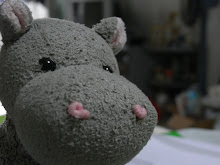 After putting down some belongings at the Tropical Marine Science Institute's (TMSI) pantry, we soon set off! For this trip, I was attached to Robert's group.
After putting down some belongings at the Tropical Marine Science Institute's (TMSI) pantry, we soon set off! For this trip, I was attached to Robert's group. The guided walk kicked off with Robert talking about epiphytes. These refer to plants which grow on other plants, like trees, so that they can get better access to light. They are not parasitic though. One example of a common epiphyte in Singapore is the Pigeon Orchid (Dendrobium crumenatum) which can be found growing on roadside trees.
The guided walk kicked off with Robert talking about epiphytes. These refer to plants which grow on other plants, like trees, so that they can get better access to light. They are not parasitic though. One example of a common epiphyte in Singapore is the Pigeon Orchid (Dendrobium crumenatum) which can be found growing on roadside trees. Greenery, away from the city.
Greenery, away from the city. Saw many of these pretty flowers growing among the grass and couldn't resist taking a picture of one. (ID?)
Saw many of these pretty flowers growing among the grass and couldn't resist taking a picture of one. (ID?) After a short walk, we soon reached the back mangroves where a very dead (it looked dried up) Paradise Tree Snake (Chrysopelea paradisi) lay among the grass. Live specimens are able to glide from tree to tree by projecting themselves into the air using a special technique.
After a short walk, we soon reached the back mangroves where a very dead (it looked dried up) Paradise Tree Snake (Chrysopelea paradisi) lay among the grass. Live specimens are able to glide from tree to tree by projecting themselves into the air using a special technique. The Sea Hibiscus (Hibiscus tiliaceus) and its characteristic heart-shaped leaves. Though there seemed to be no flowers, there were a handful of fruits.
The Sea Hibiscus (Hibiscus tiliaceus) and its characteristic heart-shaped leaves. Though there seemed to be no flowers, there were a handful of fruits. This sight greeted us the moment we stepped into the mangroves. Unbelievable. For every small convenience that we take for granted, like eating packed lunches (above), the environment has to pay the price one way or the other. These bags of rubbish were supposed to be brought to the mainland for proper disposal, but as you can see...
This sight greeted us the moment we stepped into the mangroves. Unbelievable. For every small convenience that we take for granted, like eating packed lunches (above), the environment has to pay the price one way or the other. These bags of rubbish were supposed to be brought to the mainland for proper disposal, but as you can see... ...someone has been burning rubbish right in the mangroves. The stink of garbage lingered in the mangroves with acrid fumes of burnt metal and plastic. Needless to say, it was also an eyesore.
...someone has been burning rubbish right in the mangroves. The stink of garbage lingered in the mangroves with acrid fumes of burnt metal and plastic. Needless to say, it was also an eyesore. Charred mangrove plants from the burning.
Charred mangrove plants from the burning. Nevertheless, there was still life around. Looking like a 'botak' broom are these aerial roots. If I'm not wrong, these will grow into prop roots upon reaching the ground.
Nevertheless, there was still life around. Looking like a 'botak' broom are these aerial roots. If I'm not wrong, these will grow into prop roots upon reaching the ground. Developing aerial roots with small lenticels.
Developing aerial roots with small lenticels. Let the cleanup begin! The participants got down to work right away, enthusiastically picking up rubbish.
Let the cleanup begin! The participants got down to work right away, enthusiastically picking up rubbish. Fishing nets and other rubbish often gets washed up along shores. Such discarded items often entangle animals, killing them. In total, the group collected 56 kg of rubbish (and that's not counting what the other two groups collected). Great job, everyone! :)
Fishing nets and other rubbish often gets washed up along shores. Such discarded items often entangle animals, killing them. In total, the group collected 56 kg of rubbish (and that's not counting what the other two groups collected). Great job, everyone! :)The mangroves of SJI are more or less rubbish-free for now, but within the next few days even, trash will start to accumulate again. This happens everywhere, at our mainland coasts, parks and housing estates. Without cleaners, I don't think Singapore would be clean at all. Green, yes, but not clean. If a small group of people are able to collect so much rubbish within an hour, can you imagine the amount of trash that can be gathered in one minute if each of Singapore's 4 million plus individuals simultaneously picks up a piece of litter? Better still, why not kick the littering habit and start picking up after ourselves...



No comments:
Post a Comment